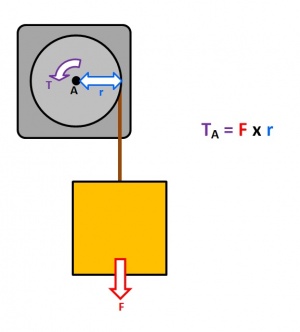Torque
Torque is the rotational equivalent of linear force. It is also referred to as the moment, moment of force, rotational force or turning effect. It represents the capability of a force to produce change in the rotational motion of the body.
Torque is defined as the product of the magnitude of the force and the perpendicular distance of the line of action of a force from the axis of rotation:
T = F * r
where
T: Torque
F: Force
r: Radius
Consider the image to the right as an example for understanding Torque. It shows a pulley connected to a motor lifting a box via a rope. The torque will act on the point A.
The box will pull down with a force:
F = m * g
where
F: Force
m: Mass
g: Gravity of Earth
The gravity of Earth is 9.81 m/s2.
Let's assume the mass M of the box is equal to 10 kilos.
The force F is then calculated like this:
F = m * g = 10 * 9.81 = 90.81 kg * m/s2 = 90.81 N.
Now, the final step to calculating the torque is to multiply the force F by the radius r (the distance from point A to the edge of the pulley.)
Let's assume the radius r is equal to 0.1 m.
The Torque will then be calculated like this:
T = F * r = 90.81 x 0.1 = 9.81 Nm.
